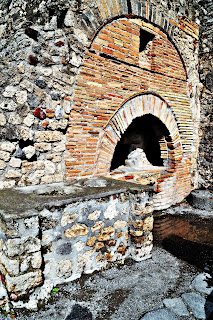Pompeii was a city built on the side of Mount Vesuvius that was destroyed or rather frozen in time when it erupted in 79 AD. The people of Pompeii were obviously devastated when the lava ran over their lives, and maybe wondered why on earth it happened to them. As Adam and I talked about it, we realized that the reason it happened was so that all of us, thousands of years later would be able to see what life was like all over the countryside. Most of the other cities disappeared over time, but this one remained frozen.
You can see where the kitchens and baths were, where houses were divided by walls and even where the large theatre and center of the city existed. The archeologists poured plaster inside of the molds that were created by ash and you are able to see people in the positions they were in when the devastation happened. You are also able to see the pottery and household items they had.
The ruins looked very much like what I thought they would. They were in a beautiful setting, high up in the hills with the sun shining and wind at a standstill. Although the area outside of the city of Pompeii is not a tourist center and absolute memory of SE Asia, the museum itself is something worth spending 11 euros on. (Only European students get a discount).
The city of Napoli sits at the foothills of Pompeii and immediately Adam and I did not feel comfortable walking around. It is a shame that the city is so dirty and there are people selling things at every toll booth. I am sure that if you knew exactly where to go, Napoli may give you a different impression, but we were unsure. The area was a bit sketchy and we decided to pay the toll and head over to the eastern coast.





No comments:
Post a Comment